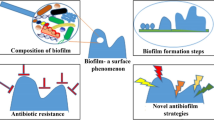Abstract.
The aim of this work was to assess the adaptation of bacterial communities to environmental transitions from labile to refractory substrates. This involved testing the hypothesis that bacteria self-organize and propagate not only as individual cellular systems, but also as functional sets of interacting organisms. A biofilm community was cultivated in a flow-cell irrigated with tryptic soy broth and subjected to a cyclic series of environmental transitions, from labile to refractory substrates, followed by a period of starvation (30 days). The appearance and disappearance of specific colony morphotypes when the emigrants were plated onto tryptic soy agar was used to monitor the restructuring of the community. Confocal laser microscopy of flow cells showed that these transitions decreased the biofilm thickness and coverage. Substrate shifts also changed the architecture of the biofilm communities. Repeated inoculation of flow-cell communities with a composite inoculum increased the number and diversity of emigrants. Their biofilms were thicker and covered a wider area than those of communities that had been inoculated only at the beginning of the experiment. With repeated inoculation, the time required for the community to restructure and stabilize decreased during most transitions. This suggested that organismal recombination acted as a mechanism of adaptation, enhancing the growth of microbial communities exposed to environmental stresses. Changes in the profiles of emigrants during the adaptation of biofilm communities to environmental transitions showed the appearance and disappearance of discrete sets of organisms. This suggested that the biofilm communities responded to environmental stresses as sets of interacting organisms. Enhanced growth of biofilm communities due to repeated environmental cycling suggested that the functionality of cellular positioning accrued from one cycle to the next and was thus heritable, although it was not necessarily genetically encoded.
Similar content being viewed by others
Author information
Authors and Affiliations
Additional information
Electronic Publication
Rights and permissions
About this article
Cite this article
Karthikeyan, S., Korber, D.R., Wolfaardt, G.M. et al. Adaptation of bacterial communities to environmental transitions from labile to refractory substrates. Int Microbiol 4, 73–80 (2001). https://doi.org/10.1007/s101230100016
Received:
Accepted:
Issue Date:
DOI: https://doi.org/10.1007/s101230100016




